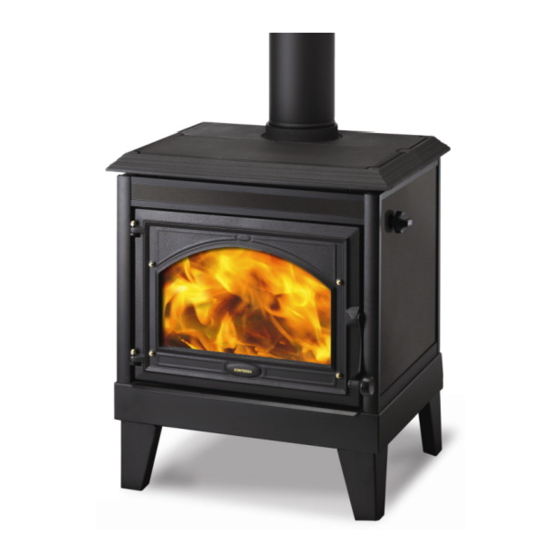Firenzo CONTESSA Instrukcje użytkownika - Strona 9
Przeglądaj online lub pobierz pdf Instrukcje użytkownika dla Piec na drewno Firenzo CONTESSA. Firenzo CONTESSA 9 stron. Freestanding clean air woodburner
Również dla Firenzo CONTESSA: Podręcznik (10 strony), Instrukcja instalacji (8 strony), Instrukcja instalacji i obsługi (17 strony)

- The combustion temperature is too low.
- Insufficient air for the combustion.
9.2.3 Ceramic glass replacement
Only replace with genuine Firenzo Robax™ glass.
Ceramic glass cannot be recycled because it has a higher melting point that ordinary glass.
If ceramic glass is mixed with ordinary glass, the raw material is spoiled, and the reclaiming process may be
halted. Take care that the ovenproof glass does not end up among ordinary recycled waste. That will be a great
benefit to the environment.
Note: Should be handed in to a recycling station as ceramic glass.
9.2.4 Refractory linings
The base of the fire uses our special Firenzo refractory kiln bricks.
The sides, back and baffle of the fire uses Firenzo Scamolex™ bricks.
The condition of the refractory linings needs to be checked annually by your chimney sweep and replaced if
signs of deterioration are evident.
9.2.5 Air supply components
Air supply components are made from high temperature bearing stainless steel and need to be checked
annually by your chimney sweep and replaced if signs of deterioration are evident.
9.2.6 Gaskets
Over time, the gaskets and seals around the stove will wear and should be replaced as needed in order to
prevent uncontrolled combustion. Use only the original Firenzo seals and gaskets.
9.2.7 General
Reasons for overly rapid wear of internal parts
- Stove fired too vigorously
- Use of very dry wood (wood from old furniture).
- Too much soot on top of the baffles (please see the section on Cleaning).
- Too much ash in the ash pan (please see the section on Ash).
Please note that no unauthorised alterations of the design may be undertaken, and that any parts that are
replaced must be replaced with genuine original Firenzo parts. Failure to comply may render the warranty
invalid.
9.3 Cleaning the stove/chimney
It is important that the stove is regularly maintained by a competent engineer and that the whole system (stove,
flue connector and flue) are cleaned regularly.
In particular on the topside of the baffle plates, layers of ashes and soot will form as a result of the chimney draft
and after a sweep.
The baffle plates may be taken out of the stove under normal cleaning. When they are removed, there is access
to clean the flue chamber above the baffle plates.
The baffle plates are cleaned before they are reinserted, and care should be taken that they are properly put in
place.
Nowadays, the chimney sweep must remove the soot in the stove, in addition to sweeping the chimney and
cleaning the flue pipe. The number of annual sweepings/cleanings of the stove should be determined in
consultation with your chimney sweep.
9.3.1 Ash
As noted above, there should be a layer of approx. 20mm of ashes in the bottom of the combustion chamber in
order to achieve a high combustion temperature. If the layer of ash is too thick, it can be scooped intoan ash
bucket and removed.
In most cases, the ash will need to be taken away by the waste disposal company. Because embers may be
concealed in the ash pan for several days, it may be necessary to store the ash in a container made of non-
flammable material before pouring it into a rubbish bag.
Ash from a wood-burning stove will not be of any benefit to your garden as fertiliser. If you have burned colour
brochures, or painted or treated wood, etc., in the stove, the resulting ash mustnot be poured onto soil as it may
contain heavy metals.
CU-2013-05-14
9
